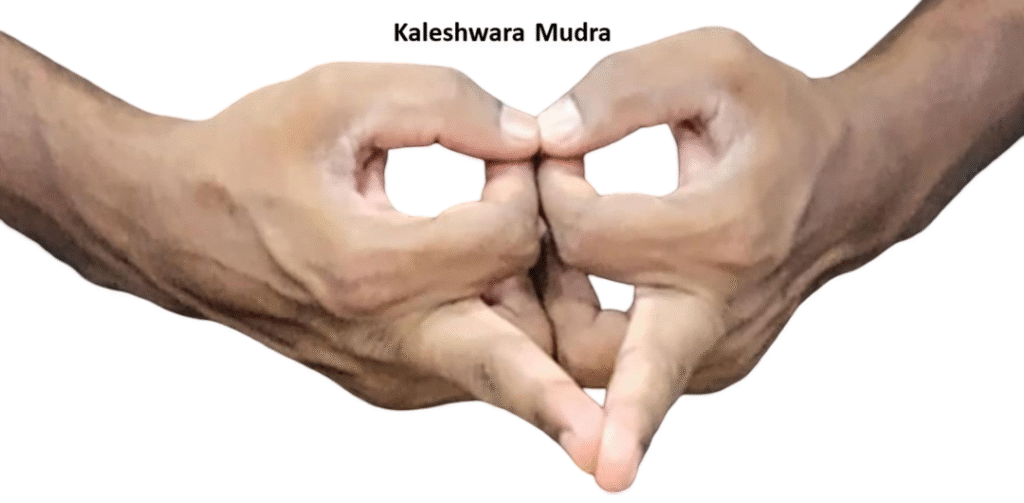Kaleshwara Mudra
Introduction
Kaleshwara Mudra is a hand gesture associated with calming the mind, focusing thoughts, and regulating emotions. It is often referred to as the “Mudra of Time”, because it is believed to bring awareness of inner rhythms, reduce racing thoughts, and help practitioners manage stress and mental agitation. The practice directs pranic energy toward the head and heart, enhancing meditation and mindfulness.
Meaning
Kaleshwara = derived from Kala (time) + Ishwara (Lord, controller). It represents the Lord of Time.
Mudra = gesture or seal.
Thus, Kaleshwara Mudra means the gesture that helps master or harmonize time, symbolically referring to mastering the restless flow of thoughts and emotions.
How to Perform (Method of Practice)
Step-by-Step Instructions:
Sit comfortably in Padmasana, Sukhasana, or Vajrasana with a straight spine.
Bring both hands together in front of the chest.
Using both hands, extend your middle fingers and bring the pads together.
Bend your index, ring and little fingers halfway into their palms and bring the backs of the respective fingers together.
Join the ends of your thumbs and point them toward your chest, spreading your elbows to the sides. Hold for as long as you like, repeating as required.
Optionally, direct awareness to the Ajna Chakra (third eye) or Anahata Chakra (heart center).
Tip: This mudra is often combined with deep breathing or meditation for maximum effect.
Benefits
Physical Benefits:
Relieves tension, stress-related headaches, and restlessness.
Reduces heart palpitations and regulates breathing rhythm.
May help normalize blood pressure.
Mental & Emotional Benefits:
Quiets excessive thoughts and mental chatter.
Promotes clarity, concentration, and emotional stability.
Useful for people with insomnia, anxiety, or restlessness.
Spiritual Benefits:
Brings awareness of inner time cycles (breath, thought, meditation rhythm).
Supports meditative states and mindfulness.
Helps practitioners move into timeless awareness during meditation.
Contraindications
People with severe depression should use cautiously, as it may deepen introspection—best practiced under guidance.
Should be avoided if holding the gesture causes hand cramps or finger pain.
Not recommended for very long sessions in people with low blood pressure and dizziness—start short.
Anatomy & Physiology
Musculoskeletal: Engages intrinsic muscles of the hand and flexor tendons while creating balance between left and right hand.
Respiratory: Enhances diaphragmatic breathing and lung expansion by calming the nervous system.
Circulatory: May help reduce stress-related blood pressure fluctuations.
Endocrine/Autonomic: Encourages parasympathetic dominance, balancing stress hormones.
Kinesiology
Involves isometric hand engagement, especially at the thumb and middle fingers.
Stimulates neural reflex zones in the fingers associated with heart and brain.
Encourages bilateral symmetry, promoting coordination between brain hemispheres.
Neurology
Activates prefrontal cortex regions involved in attention, self-regulation, and mindfulness.
Promotes parasympathetic nervous system activity, calming stress responses.
May improve alpha brainwave activity, supporting meditation and relaxation.
Duration of Practice
Beginners: 5–10 minutes daily.
Intermediate: 15–20 minutes, once or twice daily.
Advanced: Up to 30 minutes during meditation sessions.
Best practiced during quiet times (early morning or evening).
Counter Mudra
Gyan Mudra (gesture of knowledge) can be practiced afterward to enhance focus.
Apana Mudra may also be used to ground excess energy after long practice.
Conclusion
Kaleshwara Mudra is a powerful meditation aid that calms the mind, regulates emotions, and brings clarity to thoughts. It is often called the Mudra of Time because it creates awareness of the timeless inner self beyond stress, anxiety, or mental agitation. Practiced regularly, it can help cultivate peace, inner stillness, and emotional balance.
FAQ
Q1: Can Kaleshwara Mudra help with sleep problems?
Yes, practicing it before bedtime can reduce restlessness and support better sleep.
Q2: Can it be practiced while standing?
Yes, but sitting with a straight spine is more effective.
Q3: Is it suitable for children?
Yes, for short durations under supervision.
Q4: Should it be practiced with pranayama?
It can be combined with deep abdominal breathing or practiced alone.
Q5: How soon are benefits noticed?
Mental calmness can be felt in just a few sessions, while emotional stability builds over weeks of regular practice.
References
Swami Satyananda Saraswati – Asana, Pranayama, Mudra, Bandha.
Gertrud Hirschi – Mudras: Yoga in Your Hands.
Swami Niranjanananda Saraswati – Yoga Darshan.
T.K.V. Desikachar – The Heart of Yoga.
Yoga Journal & contemporary articles on mudra therapy and meditation neuroscience.

